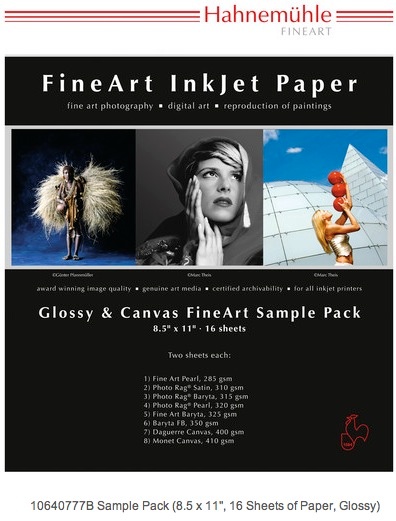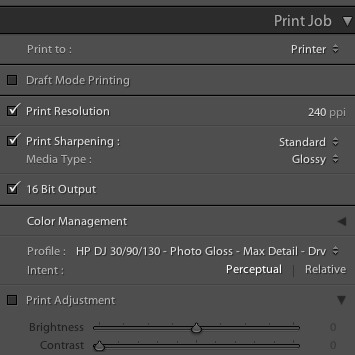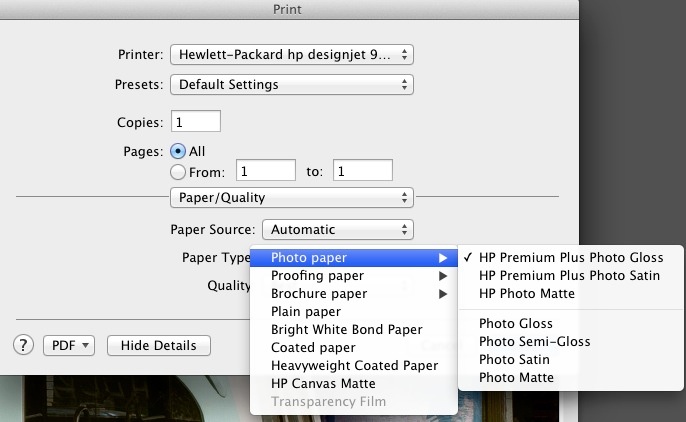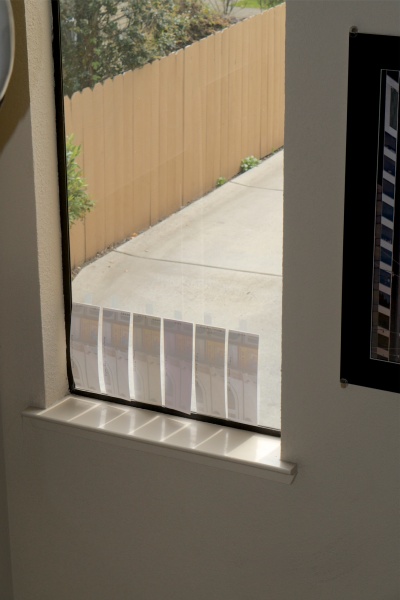Testing Hahnemühle glossy papers.

Hahnemühle glossy paper sample pack.
Tests for the Matte paper sample pack appear here. I concluded that not one of these papers was adequate for high resolution photographic prints, the color and/or texture taking out too much resolution. The heavily textured papers were downright awful.
The Glossy sample pack mysteriously includes two types of canvas paper which I consider totally unsuitable for photographic prints and did not test. Photographs are not faux paintings. They are photographs.
My first reaction on opening the glossy sample pack was one of disappointment. After discarding the two canvas horrors, only one (Baryta FB) of the remaining six papers was a true white, in fact slightly whiter than the HP-banded Premium Glossy paper, with Fine Art Pearl being almost as white. None was anywhere near as glossy as the HP brand, the Photo Rag Satin was anything but Satin (here the HP Premium Satin truly excels) being surpassingly flat and bland. How this can be included in a ‘Glossy Sample Pack’ beats me.
Paper profiles:
Hahnemühle does not provide any paper profiles for these papers when used with the HP DesignJet 30/90/130 dye printers. Accordingly, I used the stock HP Premium Glossy Maximum Detail profile, with colors controlled by Lightroom, not by the printer.
Glossy paper characteristics:

Hahnemühle paper characteristics – glossy sample pack.
Printer settings:

In Lightroom. Note that a matte profile was used for Photo Rag Satin in preference to a glossy one.

In the printer dialog. Note that the Photo Matte setting was used for Photo Rag Satin in preference to a glossy one.
As is always the case when using an HP Glossy profile, the DesignJet will hold onto the printed sheet for a few minutes before ejection, thus allowing the print to dry. It can always be manually ejected, but be aware that the surface is very fragile at this juncture.
One sheet of the whitest glossy paper, Baryta FB, had a small black blemish, maybe 0.5mm long, but enough to destroy a print if it appeared in a light area. Inexcusable.
Results:
My gradings are based on three simple criteria for a glossy print. The paper must be a stark white and the gloss has to be a high gloss or a true satin for papers named ‘Satin’. The third is that colors have to be accurate.
Color fidelity:
This was the best:
- Baryta FB
This paper is extremely heavy at 350gsm, like the matte Museum Etching paper in the earlier matte paper test. Like that paper some color tracks were left in the bottom white margin from the printer’s roller, though strangely none on the printed area. The color rendering is outstanding, identical to HP Premium Glossy, but the finish s more satin than glossy.
I cannot recommend any of the other papers – too yellow, nasty surface finish or just plain yecch! (Canvas).
Fade tests in strong sun:
I will report results for both glossy and matte papers after three months of sun exposure, compared to a control sample stored in a cardboard box.
Conclusions and alternatives:
If my tests of 16 Hahnemühle printing surfaces proves anything it’s that the HP-branded papers are very good indeed. But my remaining supply of some 120 sheets of 18″ x 24″ is dwindling, so a replacement has to be found. HP’s paper avoids ridiculous excess weight, which serves no purpose and can cause roller marks.
There is no true glossy Hahnemühle paper here. The best is the Baryta FB, and it bears more resemblance to HP Premium Satin than to HP Premium Gloss, and Baryta FB’s high weight may result in ink smudges from the feed rollers.
Hahnemühle Fine Art Pearl leaves nasty blotches viewed at an angle, and only two paper base colors equal or exceed the whites of HP Premium Glossy – that same Fine Art Pearl (forget it, because of the blotchiness) and Baryta FB whose thickness causes dirt tracks from over-pressured rollers.
All the other papers in this sample pack are too yellow to pass muster for proper color rendering. Some of the finishes belong in a morgue, not on a photographic print.
Bottom line is that there is only one paper in the Hahnemühle mis-named ‘Glossy Sample Pack’ which I can recommend, the Baryta FB with the roller pressure caution mentioned above. And it’s not even glossy.
These tests of Hahnemühle papers have been very dispiriting. Not one of their Matte papers has anything to recommend it compared to HP’s Premium Glossy and Satin offerings and the Glossy ones are anything but.
Accordingly, I did some more research and will soon be testing Moab’s glossy papers. While I originally wrote these off as not suitable for dye inks, a revisit and more careful reading of Moab’s site, spurred by the poor experience with Hahnemühle’s offerings, suggests that their papers are suitable for dye inks, come in the large cut sheet sizes (13″ x 19″, 17″ x 22″ and A2 which is 16.5″ x 23.4″ – click here for paper sizes) which I prefer, and there are even profiles available for the glossy offerings specific to the HP DesignJet 30/90/130 dye printers. That is encouraging. As glossy print appearance and permanence are the very touchstones of the photographer’s craft, it’s worth the effort to find a long-term replacement for HP’s superb but discontinued Premium offerings. And I promise that is the last time I will use the words ‘superb’ and ‘HP’ in the same sentence.
For those photographers who revel in big prints and are trying to get the best print quality using the latest high megapixel sensors, high gloss surfaces are the answer. The quickest way to turn a 36mp sensor into a 6mp one is to use something ghastly like canvas paper.
Fade tests:
As with the matte papers, I will report back in three months on the extent of fading noted after daily all day exposure to bright sun:

Three matte and three glossy test strips in the sun.
I have been considering the purchase of a HP Designjet 130, would you recommend this printer?
Check my Printing articles – see the Sitemap above.
If you are a Mac user you really must be using a Snow Leopard or earlier OS machine as anything later will not give you access to HP’s online diagnostic app. While you can run paper, ink and head usage diagnostics using just the control panel on the printer, failed ink head diagnostics can only be run using HP’s online application, which does not run with OS X Lion or Mountain Lion. You need Snow Leopard or earlier with Rosetta, or an old PPC G3/4/5 Mac. Windows is not an issue best as I know, but I do not use it.
Likewise, if you want to use the DJ’s built-in colorimeter to make your own paper profiles (yes, it has one, though I find paper manufacturers’ profiles are more accurate) you must have access to the online utility on HP’s site.
Buying new gets you a 24″ printer for $1200, half the price of any other of like quality. But HP’s support is worthless, so the ‘new premium’ cannot be realized effectively.
Buy used only if you can get the seller to run the diagnostic pages I illustrate in the above link. That will tell you if it’s a printing shop beater (tens of thousands of prints) or an amateur’s baby (a couple thousand). If the seller cannot provide that, move to another.
Worst case ‘fix up’ cost for a printer which has been in long term storage – meaning the heads and feed tubes are clogged and the inks old is:
So for a used stored one used your worst sunk repair cost is $500, not cheap and no guarantees, which means you probably do not want to pay more than $200 for one without current diagnostic reports.
I believe the best bet is a lightly used one which has not been stored and which you can see working. Local pick-up is greatly preferred to risking UPS or FedEx TLC. I would pay $400-500 for a good one. Once unplugged and stored, these clog as the head warmer is off. If plugged in (but not on – fan noise) mine never clogs, even with 6m between uses. The head warmer consumes a few watts and prevents the inik solidifying in the heads and feed tubes. So if you get one, do not unplug it – s small green LED on the control panel shows the head warmer is on.
Parts are easily obtained – HP made a lot of these machines for commercial use. Roll paper (there’s a roll paper version if that’s your thing) is easily available. Until I conclude my tests on fading of aftermarket papers (3-4m hence) you really should use HP Premium Glossy or Matte paper which is formulated to be fade free with those papers. You cannot just use any old paper, most are not suited to the DJ 30/90/130 which use dye inks not pigments.
For roll paper equipped versions the paper cutting knife which is built in to all DJs will come into action. The roll paper versions are distinguised by the suffix ‘r’ in the name – e.g. 130r. Ethernet network versions have the suffix ‘n’, so a 130nr would be the network, roll paper version. Roll paper holders can be fitted to any DJ90 or DJ130, are ridiculously expensive (hundreds of dollars for a rod and a couple of brackets) and best made at home from some parts from the hardware store and a leavening of ingenuity, for under $20.
HP has discontinued cut sheets in large sizes (13″ x 19″ and 18″ x 24″) though some supplies remain out there. Roll paper remains easily available, though I hate it because it’s a pig to work with – curl, difficulty of switching sizes, tricky to load, more clearance needed behind printer, etc.
Ink supplies and printheads are not an issue. Many of these printers remain in printshop service using rolls, and HP makes good money on inks and heads, so they keep making them.
So a qualified ‘Yes’ to your question with many caveats.
I suggest you take some time and read through my Printing link in the Sitemap above which has 7 years of discovery on my DJ90 (functionally identical to the DJ130 except for the 18″ vs. 24″ width) clearly set forth, pluses and minuses.
I love mine – finest blacks in the business – and I do not lust for anything else at any price.
New alternatives in wide carriage? Epson seem to have a lot of ink clogging issues and the printhead is integrated – no one-head-per-ink technology, unlike the DJ series. It costs as much to replace as a new $3,000 printer making the whole thing questionable. But I am repeating hearsay, not stating personal experience.
Canon I know little about.
The current HP 3200 uses pigments, not dyes, so a far greater paper choice is available to you, uses discrete print heads so cheap to replace when one blows, has very large capacity ink cartridges and is very frugal with ink like the DJ130, and even has a built in colorimeter for making your own paper profiles! But it costs almost $4,000 and once again when you call for help you will be transferred to a non-English speaking nation. Still, that’s what I would probably buy today if I needed 24″ or 44″ much as I detest everything about the HP of today from its C Suite and board of directors on down to its stock.
Ed.